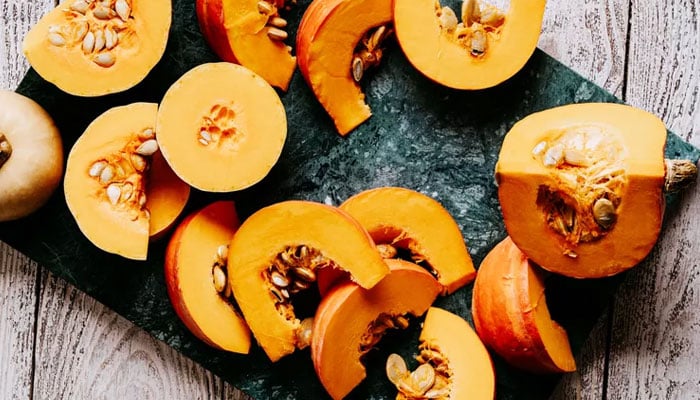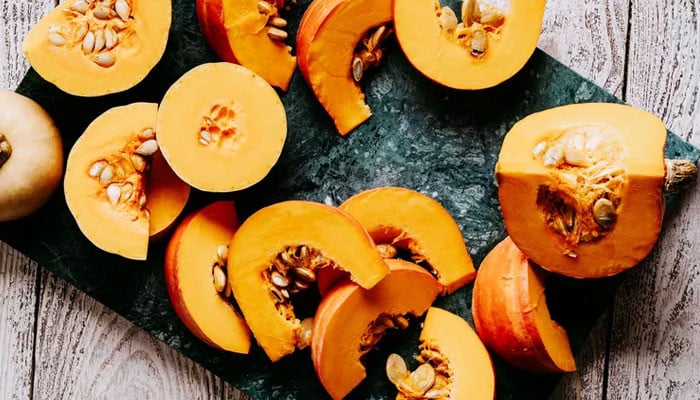
From pumpkin curry to pumpkin halwa, every dish made with this healthy food is enjoyed in the fall months, but few people know that its use has more health benefits than just taste. are
Pumpkin is a hearty and versatile food that can be cooked in many ways, pumpkins are packed with vitamins, minerals and antioxidants that add nutritional value to any meal.
Pumpkin Nutrition Facts
According to the USDA, one cup of raw pumpkin contains 30 calories, 1.16 grams of protein, 0 grams of fat, 7.5 grams of carbohydrates, 0.58 grams of fiber, 24 milligrams of calcium, 1 milligram of iron, 13 milligrams of magnesium, and 10 milligrams of vitamin C. goes
Pumpkin is considered to be a cousin of the fruit, melon, which is why its use also has numerous positive effects on health and well-being, some of which are as follows:
Better for gastrointestinal health
Fiber is an important component for human health that improves the digestive system by making it more functional and promotes regular bowel movements.
Research shows that pumpkin peels contain alcohol-insoluble polysaccharides that reduce bile acids (stomach secretions) and support the growth of gut microbiota.
Being a food rich in antioxidants, the use of pumpkin can also reduce the risk of various types of cancer.
According to research, people who eat pumpkin seeds have a lower risk of several types of cancer such as breast, ovarian, lung and prostate cancer.
Improves immune health
Pumpkin is a natural source of immune-supporting nutrients, improving overall health as it contains vitamin C, zinc, and selenium and is about 90 percent water.
It’s also rich in fiber, since 70% of our immune system is connected to our gut, eating fiber-rich foods like pumpkin can improve gut health.
A source of weight loss
According to the data collected from several studies, high consumption of fruits and starchy vegetables leads to weight loss, medical experts say that adding pumpkin to your diet is a positive option for those who want to lose weight. May be.
One cup of raw pumpkin is very low in calories, about 30 calories per cup, and high in fiber and minerals.
Improves eye health
Pumpkin is rich in vitamin A, carotenoids, lutein and zeaxanthin, all of which improve eyesight and reduce the risk of vision loss.
Controls blood pressure
Pumpkin is a natural source of many nutrients that improve heart health, potassium, calcium and magnesium help control high blood pressure.
Pumpkin is very low in sodium which increases blood pressure.
Dangers of eating pumpkin
Although pumpkin is generally a safe and healthy food to consume, there are a few potential risks.
Digestive problems can cause: Pumpkin is high in fiber so consuming too much of it can cause bloating, gas and stomach pain.
Allergic reactions can cause: Although this risk is not common, some people are allergic to pumpkin, so it is wise to avoid this vegetable if you fall into this category.
Some important tips for using pumpkin
Pumpkin Puree: Pumpkin puree can be used in a variety of sweet and savory dishes.
Roasted Pumpkin: Cut the pumpkin into pieces, fry it with a little salt using very little olive oil and drink it.
Pumpkin seeds: Don’t throw them away, pumpkin seeds are packed with nutrients, you can even eat them as a healthy snack.
Pumpkin Smoothie: Pumpkin puree can be blended with your favorite fruit juice or a little bit of yogurt to make a pumpkin smoothie.
Pumpkin Soup: A bowl of warm, creamy pumpkin soup can be a comforting winter meal.
setTimeout(function(){
!function(f,b,e,v,n,t,s)
{if(f.fbq)return;n=f.fbq=function(){n.callMethod?
n.callMethod.apply(n,arguments):n.queue.push(arguments)};
if(!f._fbq)f._fbq=n;n.push=n;n.loaded=!0;n.version=’2.0′;
n.queue=[];t=b.createElement(e);t.async=!0;
t.src=v;s=b.getElementsByTagName(e)[0];
s.parentNode.insertBefore(t,s)}(window,document,’script’,
‘https://connect.facebook.net/en_US/fbevents.js’);
fbq(‘init’, ‘836181349842357’);
fbq(‘track’, ‘PageView’);
}, 6000);
/*setTimeout(function(){
(function (d, s, id) {
var js, fjs = d.getElementsByTagName(s)[0];
if (d.getElementById(id)) return;
js = d.createElement(s);
js.id = id;
js.src = “//connect.facebook.net/en_US/sdk.js#xfbml=1&version=v2.11&appId=580305968816694”;
fjs.parentNode.insertBefore(js, fjs);
}(document, ‘script’, ‘facebook-jssdk’));
}, 4000);*/



